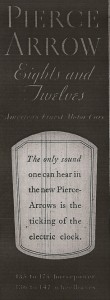
It’s in the running for the best headline of the week.
Just nine words.
But it’s so jam packed with information and authority that the world from Obama on down is probably taking notice and nodding their heads in affirmation.
Maybe you did that as well.
“Vladimir Putin views himself as second only to God.”
It’s from Mikhail Gorbachev.
So you have a testimonial from an insider that explains a lot.
It’s a full story of why we could be facing a second cold war.
There are other lines that tell a complete story.
One is known as a six-word novel.
“Baby shoes for sale. Never worn.”
That’s something Ernest Hemingway created on a bet.
It’s used to teach young copywriters how to tell a complete story in the most economical way possible.
Similarly there’s another that serves the same purpose. It’s 14 words.
“Drum kit for sale. Call the owner’s mother when the owner isn’t at home.”
How about the headlines you and your agency develop for your brand?
How strong are they? Can they tell a story that will stop your target audience and make them read on?
Do they have narrative quality?
Can they compete with a headline for a language-learning course?
The visual is an Asian woman, a close-up on her face.
The headline is “She wants to put her tongue in your mouth”.
Another for Colgate Toothpaste shows a sandwich with one bite taken out of it.
The line is “The Next Thing That Gets Eaten Is Your Teeth”.
Yet another is for a special video system for learning. It’s aimed at those who run school districts.
“A Video System So Advanced Kids May Ask To Come in On Saturday.”
One more, from a writer called Richard Foster …
Aimed at girls 11-14.
The visual is a close-up of a woman’s hand trying to get a thread to go into the eye of a needle.
The line is “Like most things in life, inserting a tampon takes a lot of practice”.
It’s for Lil-lets Tampons.
So what happened to strong headlines? Where are they when it comes to online ads, emails, white papers and Website content?
Where’s the well-judged audacity?
Too many messaging efforts these days are the height of drabness, a yawn.
But you already knew that, right?
Because isn’t that why you often go out of your way to avoid advertising?
Share with us. How do you and your agency go about creating the kind of messaging that’s the opposite of inert and dull? Leave your comment in the box below. Thanks for reading, Steve Ulin



